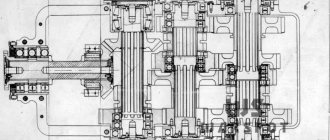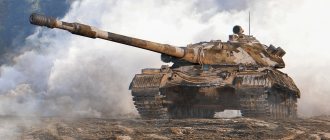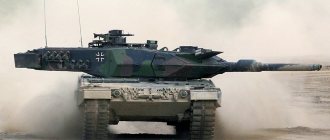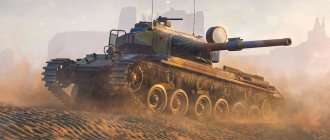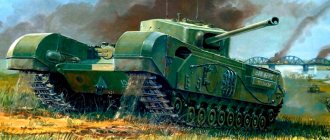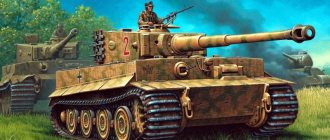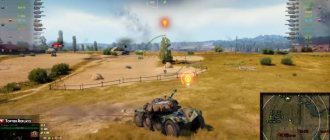Updated: May 4, 2022 at 11:36 World of Tanks BlitzGuides
IS-5 is the best solution for players who do not invest real money in World of Tanks Blitz. It’s no secret that you can play comfortably without a premium account and a premium tank in Blitz only up to level 6. Then there is a shortage of loans and a decline in the red. The IS-5 is the only car in the game that you can get almost for free and start playing as a plus without donating.
TTX IS-5
The IS-5 is a classic USSR heavy weapon with its characteristic features - large alpha, long reload time and huge dispersion.
Firepower
We will compare the hero of today's review with other premium Soviet heavyweights of level 8, as well as with the pumpable analogue of the IS-3.
One-time damage of 390 units is typical for Soviet TTs, higher only for Ob.252U (Defender). In terms of penetration , it is also no different, only lower than . The rate of fire and DPM are at an average level. The gun depression is poor, aiming time and accuracy are also among the worst.
The main projectile is sub-caliber and flies quickly, the penetration rate of the premium cumulative is 270 mm, which is normal for level 8, but its price will make you forget about farming.
Vitality
In terms of hull armor numbers, the IS-5 is not very different from other premium classmates and has a so-called “pike nose”, similar to the IS-3 and Defender.
However, in reality, it penetrates much more easily and more confidently than the IS-3, not to mention the Defender, known for its impenetrable forehead, from which shells from even level 10 tanks often fly off. All this is not about the IS-5, which is penetrated by all ST and TT at the level, fortunately there are at least screens on the sides that sometimes eat up enemy shells.
Its turret armor is also not the best, but thanks to its streamlined shape, only level 9-10 vehicles can penetrate it head-on.
Mobility and visibility
In terms of maximum speed and specific engine power, the IS-5 is the best and indeed the tank feels quite pleasant in terms of mobility.
It probably doesn’t make sense to talk about camouflage - it simply doesn’t exist. According to the review, it stands out against the background of other Soviet TTs, but in general, at level 8 the tank is frankly blind.
Historical reference
Work on the Object 730 began at the end of 1948. The goal of the project was to modernize another heavy tank, the Object 701 (IS-4). The modernization concerned a number of components and assemblies, as well as reducing the weight of the machine from 60 to 50 tons. But already the first version of “Object” differed significantly from the basic version.
About 10 vehicles were produced for military testing.
The project was accompanied by a large number of complaints from the military and representatives of the military-industrial complex. The defects were corrected, but the work was delayed. At the end of 1950, new requirements for a promising heavy tank were formulated. Further work led to the creation of the serial T-10 (aka IS-8) while maintaining the .
Selection of equipment for IS-5
In the first slot with a survivability bonus, you can install one of the following modules at your request:
- improved hardening – will increase HP by 10%; durability and speed of chassis repair by 20%
- changed layout – will increase the speed of module repair by 35%; strength of ammunition, tanks and engine by 150%
- improved turning mechanisms – will increase the turret turning speed and reduce dispersion by 10%
- ventilation - will add a little to all the parameters of the tank
In the remaining two slots we install equipment according to the classics:
- rammer – will speed up reloading by 10%
- stabilizer - will reduce spread and allow you to shoot more accurately immediately
Booking
The armor of the IS-5 allows for a more aggressive game compared to the IS-6, and this is also facilitated by its good speed, which is nominally even higher than that of the IS-3.
| Forehead armoring | Aircraft reservation | Stern reservation |
How to play IS-5
First, let's look at one of the configuration options, how the equipment will be transformed after installing the equipment, equipment and with a pumped-up crew: At the top, your task is to push the direction, but you should take into account the randomness of the armor and do not substitute thoughtlessly, since tanks at a lower level will be able to penetrate you. Hide the NLD and do not make a diamond, substituting the VLD at an angle convenient for the enemy.
Keep in mind that tanks standing higher can easily penetrate you.
In the middle of the list you are left with only support, stick to well-armored tanks or tanks, supporting them with your fire when the enemies shoot at them. Do not expose yourself to fire ahead of time, it may end badly for you.
If possible, tank by rotating the hull (the sides are protected by screens and have rational armor angles) or from the turret due to the embankment.
At the bottom of the list, you will feel the real pain of facing TTs and PTs of level 9-10, so here it is better to support the attack of allied CTs on the flank. Your alpha will come in handy there, plus the armor will probably be able to repulse something.
In any case, due to the terribly oblique weapon, standing in the bushes makes no sense. You are unlikely to hit anyone and shoot from a long distance. In this case, you may have to charge the gold and work from the second line.
Armament
One of the main distinguishing aspects of this tank is that, unlike its classmate IS-6, it has sub-caliber shells in its ammunition instead of conventional armor-piercing shells.
Thus, players will be able to feel a positive difference both in penetration and in the economic component - these shells are available for purchase for in-game silver. In addition, the IS-5 has cumulative projectiles that will allow it to operate successfully even against tanks of a higher level.
Crew:
- Crew commander (radio operator);
- Gunner;
- Driver mechanic;
- Charging.
Learning additional skills for the crew:
Standard crew:
| 1 | 2 | 3 | 4 |
For the first slot, we teach all crew members, except the commander, the “ Repair” , and for the commander the “ Sixth Sense” skill - the “Repair” skill speeds up the repair of damaged modules, and the “Sixth Sense” will allow you to determine whether his tank has been detected by the enemy. Also, all crew members need to learn the additional skill “ Combat Brotherhood” , which will improve the level of proficiency in the specialty - be sure to learn it all at once, preferably used in the second or third slot.
- the Eagle Eye skill , which increases the viewing range.
- For the gunner we learn the skill “ Smooth turret rotation” , which reduces the spread when turning the turret; and the Sniper , which increases the chances of causing damage to modules and crew members.
- For the driver mechanic, we learn the “ Smooth Move” , which reduces the dispersion of the gun in motion; and the Off-Road King , which reduces drag on soft to medium ground when driving.
- For the infector, we learn the skill “Non-contact ammo rack ,” which increases the strength of the ammo rack; skill “Desperate” , which reduces the reload time when less than 10% strength remains.
Development
Development
But the declared mass production attack did not mean that in September 1943 the new tanks had already gone into battle. Difficulties of a production and technological nature delayed the shipment of the army vehicles until mid-November 1943. They were waiting for the tank, they had high hopes for it, which (alas!) were not destined to come true. The very first front-line tests of the KV-85 and IS-85 showed that heavy tanks often had to be distracted from their main task - breaking into enemy defenses to fight German tanks, and in this they could not particularly boast of their victories.
Against heavy tanks, and especially the Artshturm-2 assault guns (StuG 40), tanks could only effectively use their 85-mm guns from a distance of no more than 400-600 m, when their armor was no longer an obstacle to armor-piercing guns (and especially - sub-caliber) shells from Tiger, Panther and assault guns. Self-propelled guns "Ferdinand" and "Nashorn" could hit the new Soviet tank from a distance of 2000 m or more. Even the most popular German anti-tank gun of that time, the RaK 40, successfully dealt with the IS, firing from a distance of 500-800 m at the sides and turret of the tank. Under these conditions, the first priority was to arm the IS tank with a powerful artillery system, which the NKV repeatedly demanded from the State Defense Committee.
Immediately after the failure to resume production of the 107-mm ZIS-6 tank gun, TsAKB, under the leadership of V. Grabin, decided to develop a similar product, but based on the ballistics of the 100-mm B-34 naval gun, for which there was an abundance of shells.
Side view of the IS-85 manufactured in January 1944.
The situation was made easier by the fact that the S-3 100-mm field gun was already in operation. Based on some documents, it can be assumed that the 100-mm tank gun was manufactured and first fired in September-October 1943. Most likely, it was an experimental ZIS-6 gun converted to a 100-mm caliber, the production of which was reported by V. Grabin reported to E. Satel on October 10, but until February 1944 the 100 mm gun was not going to be installed on the tank.
The author of the idea of arming the IS tank with a 122-mm caliber gun was Zh.Ya.Kotin himself. Back in early August 1943, while studying the results of the Battle of Kursk, he noticed that the only artillery system that successfully dealt with the German Tigers at all distances was the 122-mm A-19 hull gun. The 85-mm anti-aircraft guns, the ballistics of which were taken as a basis when creating the D-5 G, which was installed on the KV-85 and IS-85, turned out to be ineffective when firing against the frontal armor of the Tigers from a distance of more than 600 m, and at short distances distances differed very little in armor penetration from 76-mm cannons firing BR-350B (and even more so BR-350P) shells. Around August 10, 1943, he sent a letter to Plant No. 9 of the NKV with a request to consider the possibility of installing a 122-mm A-19 gun in the turret of the IS tank. The management of the plant and its artillery design bureau responded that the universal recoil devices developed and tested by them on the D-5 cannon and the M-30 howitzer make it possible to install all types of available field guns in a single cradle, except for the 152-mm ML 20 gun-howitzer, and suggested Zh. Y. Kotin provided preliminary designs for installing a 122 mm A-19 gun and a 152 mm M-10 howitzer in a tank turret. True, these solutions were possible only if a muzzle brake was introduced into the design of the guns.
The version of the IS tank with the 122-mm A-19 cannon was very popular with the People's Commissar of the Tank Industry V. Malyshev, but the military sharply protested against the muzzle brake, believing that its use would greatly unmask the tank when firing, and would also not allow infantry troops to fight while standing on the armor of a combat vehicle. Subsequently, combat experience confirmed that they were right, but at that time there was no other solution - a powerful tank gun was needed. By decision of the NKV, Plant No. 9 was ordered to carry out urgent production of a tank version of the A-19 gun with a piston bolt and present it by November 11, 1943.
The GKO meeting that soon followed decided the fate of the armament of the IS tank. The voices of those present were divided. Some defended a 100-mm cannon with unitary ammunition, others - a powerful 122-mm hull cannon, which could “with one blow” disable not only tanks, but also concrete pillboxes. The latter was recommended for service, ordering that its first version be installed in the IS tank and tested by firing by November 27, 1943. At the same time, it was ordered to equip this gun with a wedge semi-automatic breech and begin its production in 1944. For the 100-mm cannon designed by TsAKB, the production of which was also allowed on an experimental basis, it was ordered to make a mechanism to facilitate loading while the tank was moving (according to the “History of artillery production at Plant No. 9 during the Great Patriotic War”).
24-26 Experimental IS-122 tank (Object 240), armed with a 122-mm D-25 gun (A-19 tank) in the courtyard of the Chelyabinsk Kirov Plant. Autumn 1943
The first sample of a 122-mm tank gun, also called the A-19 tank (or D-2 tank), with a piston breech, was ready on November 12, 1943 and soon entered testing. The new gun was an experimental 122-mm D-2 field gun installed in the cradle of an 85-mm D-5 gun (the diameter of the D-5 cradle fully corresponded to the diameter of the D-2 cradle). The experimental T-shaped muzzle brake from factory No. 9 was also transferred to the tank from the D-2 gun No. 2 (it was believed that this form of muzzle brake would significantly reduce the unmasking effect during shots due to the direction of the braking jets of gases parallel to the ground).
State tests of the IS-122 tank (object 240) were carried out hastily and showed satisfactory results. True, it was not without emergency. During the first shot, the cast T-shaped muzzle brake of the gun was torn and the flying fragments almost hit K. Voroshilov, who was present here. After this, the muzzle brake was replaced with another one - a German type (its design was to a certain extent borrowed from the muzzle brake of German 88-mm guns and 105-mm howitzers), with which the gun went into mass production. It is interesting that when describing the progress of testing the gun for armor penetration, different authors cannot agree on the type of German tank that was fired at. Some claim that the fire was fired from a distance of 1500 m at the Panther tank, others place the Tiger tank there, sometimes moving the target 2000 m, but the result in all cases is the same: “... the shell pierced the frontal armor and. hitting the stern sheet, tore it out along the weld seams and threw it back at a distance of 5 meters...” (some boldly throw the stern sheet 15 meters). This version came from the description of “The History of Tank Building at the Kirov Plant,” which was slightly embellished later. During these tests (test site report No. 314 dated November 21), fire was fired at the empty, already shot and repeatedly burned hull of the Panther tank, and a 122-mm blunt-headed projectile pierced the side armor of the turret turned to the right and, hitting the weld area on the opposite side, he tore it off by welding and threw it to the ground. The shelling of complete samples of captured tanks from the serial IS-122 was carried out at the UZTM artillery range in January 1944 and showed that standard sharp-headed and blunt-headed 122-mm shells can penetrate the frontal armor of the Panther tank only from a distance of 600-700 m, and only an improved sharp-headed armor-piercing tracer projectile with an explosive chamber (made according to drawing No. 2-2868 A1) hit it from 1200-1400 m (but this projectile has not yet been adopted for service). True, in the case of shelling of the Panther with high-explosive fragmentation grenades, much more interesting results were obtained. consisted of cracking of welds and complete departure of the frontal sheet from its intended place. The “Tiger” turned out to be somewhat weaker - its forehead was freely penetrated by a standard blunt-headed projectile from 1200 m, and an improved sharp-headed projectile from 1800 m, but from such distances only well-trained crews could conduct targeted shooting from the IS, since the quality of the optical glass of the sights was insufficient . In addition, a cloud of dust (snow, water from puddles) that flew up from the ground during the first shot completely covered the target for 5-30 s, sometimes completely contaminating the sight lens. This was a consequence of the use of a muzzle brake and required the sight lens to be equipped with a special hood
Experimental tank IS-122 (Object 240), armed with a 122-mm D-25 gun (A-19 tank) during State tests. Autumn 1943
In December 1943, the IS-122 tank was put into production at ChKZ. At the same time, the IS-85 tank was produced here and the production of the KV-85 tank was ending. By the end of the year, 67 IS-85 and 35 IS-122 tanks left the plant’s workshops (with a plan of 50 IS-85s and 100 IS-122s). At the beginning of 1944, ChKZ produced another 40 IS-85, after which production of this variant was discontinued. The IS-122 continued to be mass-produced in ever-increasing quantities, which began to be equipped with the new 122-mm D-25T gun, distinguished by the presence of a horizontal wedge semi-automatic bolt, a little (from 1 - 1.5 to 1.5-2.5 rds/min .) increased the rate of fire of the gun, as well as equipped with a new optical sight. But at the same time, the semi-automatic bolt increased the gas content of the fighting compartment when conducting intense fire, and the large weight of the ammunition limited the loading speed, so that the actual combat rate of fire from IS-122 tanks during the war did not exceed 1.5 rounds/min. It is also interesting to add that since March 1944, the “German type” muzzle brake of the D-25T gun was replaced by a muzzle brake designed by TsAKB, which had a simpler manufacturing technology and high efficiency. Until production of IS tanks ceased in mid-1945, 3,483 IS-122s were produced. moreover, 60 tanks were assembled in Leningrad at the restored Kirov plant in 1944.
After the appearance of the IS-122, experiments with other weapon options did not stop. Still, separate loading, low rate of fire and small portable ammunition forced the designers to look for other solutions. On December 27, 1943, GKO decree No. 4851 was issued on arming the IS tank with new powerful arts. Among them were the 85-mm high-power tank gun D-5-T-85BM and the 100-mm tank gun S-34. equipped with a loading facilitation mechanism. In February 1944, design work began on installing the above-mentioned guns in the turret of the IS-85 tank.
Since the spring of 1944, IS-85 tanks were renamed IS-1 by order, and IS-122 tanks were renamed IS-2. Therefore, the newly created tanks had to receive the indices IS-3* (Object 244) and IS-4* (Object 245). At the instigation of OKB No. 9 (F. Petrov), the director of Experimental Tank Plant No. 100 decided that the IS-4* was to be armed with a 100-mm D-10T tank gun and therefore included this particular vehicle in the plans for experimental work with the number “object 245.” Soon, a request was received from the People's Commissariat about the progress of work on the IS-4 tank for the S-34 gun, which, naturally, did not begin. After ongoing clarification of relations with TsAKB and NKTP, this tank was also included in the experimental work plan, but under the designation IS-5 (Object 248) (not to be confused with the IS-3 (Object 703) and IS-4 (Object 701) tanks).
There were no problems with the production of the IS-3 (Object 244). One of the IS-85 tanks was simply equipped with a D-5-T-85BM gun and sent for testing. But the use of this weapon in a tank did not provide any practical advantages; the initial velocity of the projectile did not exceed 900 m/s, and armor penetration did not reach the value specified in the assignment. The tank was rejected.
The next two tanks, before the introduction of sequential numbering of ISs, were in the People's Commissariat under the symbol IS-100. Actually, according to the decision of the State Defense Committee, it was supposed to produce the IS-100, armed only with the S-34 TsAKB gun, but its installation required rearranging the fighting compartment, and the tank builders categorically did not like this.
The IS-122 tank with a “German type” muzzle brake, equipped with a PT-3 rut trawl, is being tested. 1944
An IS-122 tank with a “German type” muzzle brake is moving along the Riga Highway. 1944
IS-122 tank in the assembly shop of ChKZ. 1945
Options for the muzzle brake of the IS-122 tank
Therefore, the Kirovites were more in favor of the IS-100 armament proposed by OKB No. 9. However, after some not entirely polite correspondence with the People’s Commissariat, they had to produce both options.
IS-4 (Object 245) was a regular serial NS-122, only equipped with a 100-mm D-10T cannon. However, its competitor IS-5 (Object 248) had an “inverted” gun armored mask. This was caused by the need to place the gunner of the S-34 cannon on the right. The commander's cupola with the commander's workplace was moved accordingly to the right side of the tower roof. In addition to the gunner, commander and loader, who was located to the left of the gun, the turret was also supposed to house a mechanical shot rammer, and subsequently it was planned to install a sight stabilizer. But they were not submitted for the first tests.
The first joint tests of tanks turned out to be unsuccessful for both in all respects. The design of the gun cradle was not strong enough, and the recoil devices were “crying.” The tanks were rejected, but the range workers liked the IS-5 more, as it provided better working conditions for the gunner and loader.
From July 1 to July 6, 1944, joint testing of the IS-4 and IS-5 tanks with the D-10 gun from OKB No. 9 and the S-34 gun from TsAKB continued at the Gorokhovets training ground. Now, more reliable operation of the mechanisms of the D-10 cannon in the turret of the IS tank was noted, but the impression of the tank was spoiled by insufficient ammunition for the gun (30 rounds), poor ventilation of the fighting compartment and great difficulties for the loader. The S-34 gun was again acting up; in addition, the breech of the gun, which rolled back when firing, could hit the tank commander, whose workplace should have been moved even further to the right.
IS-4 tank (Object 245), armed with the D-10T gun, after firing tests. Summer 1944
In October 1944, TsAKB once again improved its product. A rammer appeared in the IS-5 turret. The gun's ammunition load was increased to 39 rounds. The tank commander's workplace was moved even further to the starboard side, and the cradle design was also modified. Tests confirmed the significantly increased combat qualities of the tank. In terms of rate of fire, for example, the IS-5 left behind all known heavy tanks, and in terms of armor penetration and accuracy of shooting on the move (after installing a sight with a stabilized line of sight) it also had no equal at that time. But the production of an IS tank with a 100 mm gun was considered impractical.
Vyacheslav Malyshev, in his letter to L. Beria on October 18, 1944, about the reasons for refusing mass production of IS tanks with a 100 mm gun, wrote that at present a 100 mm gun will not give a heavy tank any serious advantages, since 122 mm guns “...now capable of fighting all enemy tanks at a distance of 1700 m or more...”, and their high-explosive effect is much greater than that of 100 mm. This was related to that. that since August 1944 the quality of the armor of German tanks has deteriorated sharply.
On a trial basis at the end of 1944, experimental long-barreled 85-mm high-power guns (ZIS-1PM and S-34-1 V) with an initial projectile speed of 1000 and 1040 m were also installed in the turret of the experimental IS-5 tank (Object No. 248). /s (created in OKB No. 92 and TsAKB under the influence of the 88-mm German KwK 43 gun), but their tests were unsuccessful.
In the fall of 1944, NATI and the design bureau of plant No. 222 proposed a model of the IS flamethrower tank, intended for fighting in the city. The tank was supposed to receive a slightly modified armored mask of the KV-8 flamethrower tank with a weapon elevation angle of up to 62-65°. The project was approved, but the authors have no information about its future fate.
Heavy tank IS-5 (Object 248). armed with a 100-mm S-34 TsAKB cannon, after field firing tests. Summer 1944
On February 17, 1945, IS-85 and T-34 tanks equipped with 50-mm breech-loading mortars to protect the tank from grenade launchers in close combat were tested at the chemical test site in Kuzminki. But the installation of mortars was considered unsuccessful, since it was possible to fire from them only in a sector of about 50° on both sides of the longitudinal axis of the vehicle, while all-round fire was required, and the mortar had a fixed elevation angle, which limited its use in urban conditions. The mortar was sent to the designers for modification.
It is not only IS weapons that have become the subject of close attention of designers. The armor of the breakthrough tank was no less of concern. The results of the shelling and the first battles of the ISs showed that the armor resistance of the frontal part of the hull is insufficient to counter the armor-piercing shells of the German guns of the Tiger and Panther tanks.
In January-February 1944, NII-48 received the task of conducting research on the topic: “Research on ways to improve the armor resistance of the hull of the IS heavy tank.” The goal of the research work was to determine a set of measures to increase the resistance of the tank hull against German armor-piercing 75-mm and 88-mm shells. Numerous studies have shown that with the existing hull shape, it will be guaranteed against penetration by German 75-mm and 88-mm armor-piercing shells only if armor with a thickness of at least 145-150 mm is used. The impression was also aggravated by the quality of the armor casting of the serial IS tanks. At the beginning of 1944, in order to increase the armor resistance of the hull, they tried to harden it to a very high hardness (previously, all thick armor in the USSR was hardened to medium hardness). Theoretically, this measure should have improved the armor resistance of the hull by 14-19%, but in practice it led to a sharp increase in the fragility of hull parts, especially in the area of welded joints. So, during a test firing of an IS tank produced in March 1944 from a 76-mm ZIS-Z gun. the tank's turret armor was broken through from all directions by armor-piercing BR-350B shells fired from a distance of 500-600 m, and the shells for the most part did not penetrate the armor, but caused the formation of large masses of secondary fragments.
Reference model of the IS-122 tank “with a straight nose.” ChKZ, 1944
Testing of the DShK anti-aircraft turret on the IS tank. 1945
This fact also largely determined the large losses of the IS-85 and IS-122 tanks of the first series in the battles of the winter-spring of 1944. According to the results of several studies by NII-48 and its Moscow branch, the hardening modes in the production of serial tanks were changed, and the contents were optimized carbon in casting. The experiment also revealed a weak point in the bow of the hull, located “in the cavity of the front saddle.” To radically improve the hull's resistance, the researchers recommended changing the shape and design of its bow, eliminating the saddle-shaped recess.
The new hull, while maintaining the thickness of the main armor at 120-100 mm, was aptly named “with a straight nose.” It has become not only more durable, but also easier to manufacture. The driver's hatch plug was removed from the front plate, since in real combat there were quite frequent direct hits into it, which disabled the tank. On August 1, 1944, the “straightened nose” modification went into mass production (foreign researchers call it the “IS-2M Tank”, but in domestic documents it was never called that). The alteration made the top plate of the front of the hull theoretically invulnerable, but in practice there were cases of it being penetrated by the 75-mm cannon of the Panther tank, or the 88-mm gun of the RaK 43. This was apparently caused by defects in the production of hull parts. However, even those tanks that had standard armor on the upper frontal plate were hit by all German anti-tank guns on the lower frontal plate. To increase the armor resistance of the lower frontal plate (especially in tanks with a solid nose piece), by order of the NKTP on June 15, 1944, the Kirov Plant began installing mounts for spare tracks on it.
Due to the lack of liquid armor on the UZTM, which is completely absorbed by the cast turret production program, to save it in the production of IP cases, a welded bow design was proposed here. In this modification, the lower frontal plate was made of rolled 100-mm armor plate (problems with rolling were completely resolved in 1944) and connected to the upper cast part with a shaped groove proposed by NII 48.
During the manufacturing process, the tank's turret was also modified. The turret of the first series produced in 1943 had a narrow embrasure for mounting an 85 mm gun. But, despite the fact that the cradle of the D-25 gun was the same as the D-5, when installing a 122-mm gun, which had a large breech, it became very inconvenient to use the telescopic sight (and with the introduction of a horizontal wedge bolt, these difficulties have increased).
In April 1944, a special high-hardness turret was developed for the IS-122 tank, somewhat similar to the one that was later installed on the IS-4 (Object 701-6). The peculiarities of the turret were that, to simplify production, the installation of a stern machine gun was excluded from it, the forehead of the turret was narrowed, which should have affected the resistance to armor-piercing shells. The commander's cupola was moved almost 100 mm to the left for easier placement of the commander. In total, about 82 towers were made in this way, which turned out to be quite complex, and most importantly (contrary to expectations) - not strong enough. In the summer of 1944, the IS-122 tank had its original turret returned, the frontal part of which underwent some modifications. The turret embrasure was increased, which made it possible to move the sight to the left for more convenient use. The thickness of the oscillating armor of the gun mantlet was increased, as well as the thickness of the turret sides in their lower part. The commander's cupola has moved to the left by 60-63 mm.
38 Testing of a prototype of the D-30 gun and suspension options intended for the IS-6 tank. Autumn 1944
The evaluation of the D-30 gun and new suspension intended for IS-6 tank.
Autumn 1944.
Tests of the suspension of the IS-6 tank on the loaded IS-85 tank (Object 244).
The search for increasing armor resistance led to the development at ChKZ and Plant 100 in 1944 of the Object 701 (future IS-4) and Kirovets-1 (future IS-3) tanks, but their mass production required a restructuring of the entire production, which could affect the production volume of heavy tanks (as was the case with the development of the IS-85), which was unacceptable. Therefore, the design bureau of plant No. 100, before the start of serial production of the Kirovets-1 tank adopted for service, proposed to put into production an intermediate version, called IS-2, modernized according to the 2nd option. The new modification was a very interesting design. It retained the main body of the IS-2, but received a completely new nose shape. Now the bow of the hull was welded from two sheets of rolled armor with a thickness of 100 and 120 mm, additionally connected “into a spike” and located at large angles, like the T-34 (but version No. 7 NII 48). In accordance with this, the layout of the control and combat compartments was changed and a cast hemispherical turret of the Kirovets-1 (IS-3) tank was installed on it. At the same time, the tank retained the serial V-2IS engine with power and cooling systems (the stern of the tank was not altered at all), which made it possible to switch to its mass production almost immediately after being put into service, and it could be driven in parallel with the IS-2, while simultaneously mastering IS-3.
Some researchers call this tank a prototype of the IS-3, but this is not entirely true. The tank was indeed designed according to the technical specifications that led to the creation of the IS-3 tank, but it was built somewhat later than testing of the latter began. Test firing showed good shell resistance of the frontal part of the tank, but the State Defense Committee considered it inappropriate to put it into series.
I would also like to note that several experimental IS tanks were used as a mobile laboratory when testing the chassis of the Object 252 tank. It received large-diameter support rollers and was loaded with cast iron pigs to match the weight of the new tank. A similar solution was used when testing the chassis of the IS-7 tank.
More detailed information about the technique:
The IS-5 battle tank (Object 730) can be said to be the predecessor of the ninth level IS-8. Externally, they are very similar to each other, but the characteristics differ significantly. The 122 mm D-25TA gun has high one-time damage and excellent penetration, which allows it to deal damage to the ninth and tenth levels, however, the accuracy and long aiming force the gun to be used only at close and medium distances. Also, do not forget that sub-caliber shells at a distance lose their penetrating power, which is why there will often be a tendency to ricochet and not penetrate. The armor is good, which allows you to successfully reflect enemy shells from the seventh level and below. It is quite difficult to cause damage to the frontal part due to the shape of the body, which resembles a pike muzzle. However, the lower armor plate has weak armor, as well as the presence of two hatches on the roof of the turret through which damage can be caused. Good running performance allows you to quickly change flank in case of danger or cooperate with other main forces for a breakthrough.
In summary: The IS-5 tank (Object 730) has good characteristics and also allows you to earn credits and experience. You can also use it as a simulator for transferring to the base IS-3.
Advantages and disadvantages
The naked eye can see that the tank in our hands is really strong, this is evidenced by its general characteristics and some weapon parameters. But to fully understand how to play the IS-5 World of Tanks
, it is worth highlighting its strengths and weaknesses separately. Pros: • Good frontal and side armor; • Low silhouette; • Good mobility; • Powerful alpha strike; • Decent damage per minute; • High penetration rates. Cons: • Short viewing range; • Frequent crits of ammunition (when firing at the front of the hull); • Poor accuracy (scatter, convergence, stabilization); • Uncomfortable vertical aiming angles; • No preferential level of battles.
Modules:
Turrets/guns
| Lv. | Tower | Armor (mm) | Rotation (deg/sec) | Review (m) | Weight, kg) | Price (credits) |
| VIII | IS-5 (Object 730) | 201/129/90 | 24 | 360 | 10 500 | 30 000 |
Compatible weapons:
| Lv. | gun | Penetration (mm) | Damage (HP) | Rapid fire (rounds/min) | Spread (m/100m) | Mixing (c) | BC | Weight, kg) | Price (credits) |
| VIII | 122 mm D-25TA | 221/270/61 | 390/390/530 | 4.76 | 0.46 | 3.2 | 30 | 2 590 | 125 140 |
Engines
| Lv. | Engine | Power (hp) | Fire probability (%) | Weight, kg) | Price (credits) |
| IX | V-12-5 | 700 | 15 | 1 024 | 84 000 |
Chassis
| Lv. | Chassis | Max. load (t) | Turning speed (gr/sec) | Rmin | Weight, kg) | Price (credits) |
| VIII | IS-5 (Object 730) | 54.9 | 26 | B/2 | 10 000 | 30 000 |
Radio stations
| Lv. | Radio station | Communication range (m) | Weight, kg) | Price (credits) |
| VII | 10РКМ | 440 | 100 | 18 600 |

